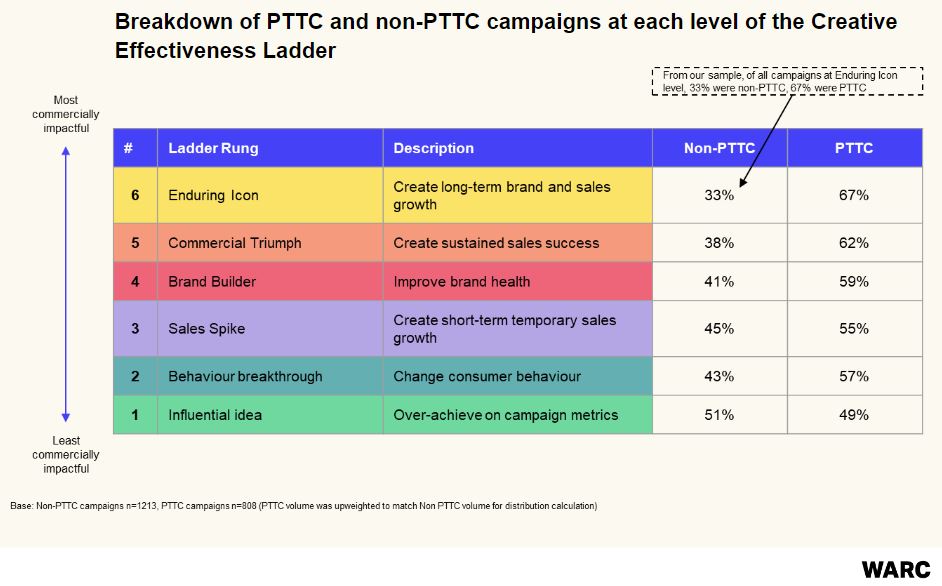News - News In Brief
Campaigns that make a clear ‘Promise to the Customer’ more likely to drive brand health, market share, and long-term sales, new research finds
June 21, 2023

The B2B Institute, LinkedIn’s marketing think tank, in partnership with WARC, have published “Making a Promise to the Customer: How to give campaigns a competitive edge,” a white paper to help brands create more effective marketing by placing a clear Promise to the Customer at the heart of their strategy.
A Promise to the Customer (PTTC), is a proxy mental model that allows marketers to deploy familiar marketing frameworks in a way that is much more easily understood by the C-suite, other functions within their organisation, and customers.
PTTC works both as an upstream organizing principle, helping the business interpret what the marketing department is trying to achieve, as well as a downstream impetus to creative communications. Data suggests that PTTC appears to have an edge when it comes to delivering positive impact on brand metrics and sustained commercial impact.
PTTC puts accountability to the customer at its core and delivers against the basic pillars of marketing: Product, Price, Place and Promotion.
Drawing on WARC’s extensive database of B2B and B2C effectiveness case studies, over 2,000 award entrants and winning advertising campaigns from the last five years (2018-2022) were analysed, of which 40% (808) were identified as having made a credible Promise to the Customer.
The study found that PTTC campaigns deliver a significant brand and commercial advantage compared to those that don’t:
- When campaigns are grounded in an explicit Promise to the Customer - a memorable, valuable and deliverable promise - they are as much as 48% more likely to report brand health improvements than those that don’t.
- The impact was consistent regardless of budget, duration, or number of channels used (the three drivers for measuring a campaign’s Creative Commitment). PTTC can therefore offer a competitive advantage to smaller or scale-up brands, or be a useful approach for marketing departments under budget pressure.
- PTTC campaigns deliver a commercial advantage - they are 60% more likely to report increased market share, and 17% more likely to report increased market penetration than non-PTTC campaigns.
- To assess the depth of commercial impact, PTTC campaigns were analysed against the Creative Effectiveness Ladder. At all but the lowest rung, PTTC campaigns over-indexed against their non-PTTC counterparts. Additionally, PTTC campaigns are more prevalent at the higher levels of the Ladder, with 67% of PTTC campaigns reaching Enduring Icon level, versus 33% of non-PTTC campaigns.

Jann Martin Schwarz, Founder and Head of The B2B Institute at LinkedIn, said: “It’s exciting to see the PTTC mental model validated against such a significant body of research, and to see that ad creative which focuses on understanding “what is the promise this product makes to the customer?” translates into much better campaigns, as well as being easier to understand and operationalize by many parts of a business.”
Roger Martin, CEO advisor, strategist, former Dean of the Rotman School of Management and author of “Playing to Win,” “The Design of Business,” and “A New Way To Think”, said: “In the four decades I have been working on strategy and branding, this PTTC finding is the single most exciting discovery with which I have been involved. It reinforces my long-held belief that B2B and B2C branding are more similar than different. In both domains, the power of a brand is strong, but only takes shape when the entire organization coordinates its efforts to design, make, project, and fulfil a PTTC. PTTC establishes both a compelling imperative and a helpful roadmap for overcoming the often siloed worlds of product, marketing, go-to-market, and customer loyalty. It is now crystal clear that if a company isn’t making a clear PTTC, it is wasting its advertising spending for no reason other than engrained bad habits.”
“The problem with ‘brand’ is that it has become a complicated concept that means many things to many people. The idea of a Promise to the Customer is a big simplification, and means that ‘brand’ can be understood by everyone. The concept of understanding and projecting the right promise captures many of The B2B Institute’s foundational findings that we worked on with the Ehrenberg Bass Institute, such as our work on Category Entry Points and the importance of building mental availability in buying situations.”
Mimi Turner, Head of EMEA at the B2B Institute at LinkedIn said: “For me, the most interesting finding in this research was what happens with lower-budget campaigns. In marketing, big is usually better. Big brands with big budgets usually have the advantage. But only a few marketers have the luxury of that kind of scale.
“When we applied a Promise to the Customer lens to campaigns with lower budgets, lower duration and fewer distribution channels, we found that making a Promise to the Customer made campaigns much more successful across brand health, market share and long-term sales outcomes than campaigns of the same scale that did not have a Promise to the Customer. That’s something that marketers who are struggling to compete for budget can really use to drive better results.”
David Tiltman, SVP Content, WARC, said: “Over time we’ve realized how important language is to securing buy-in for marketing investment. Terms like ‘brand’ and ‘purpose’ are not always viewed favorably outside the marketing team. That’s why we’re interested in new frameworks that can circumvent these preconceptions.
“PTTC is an exciting idea because it can work both at a corporate level and as a starting point for creative communications. And as we are starting to see in the analysis, this approach can deliver real benefits in terms of brand health and long-term sales impact.”













